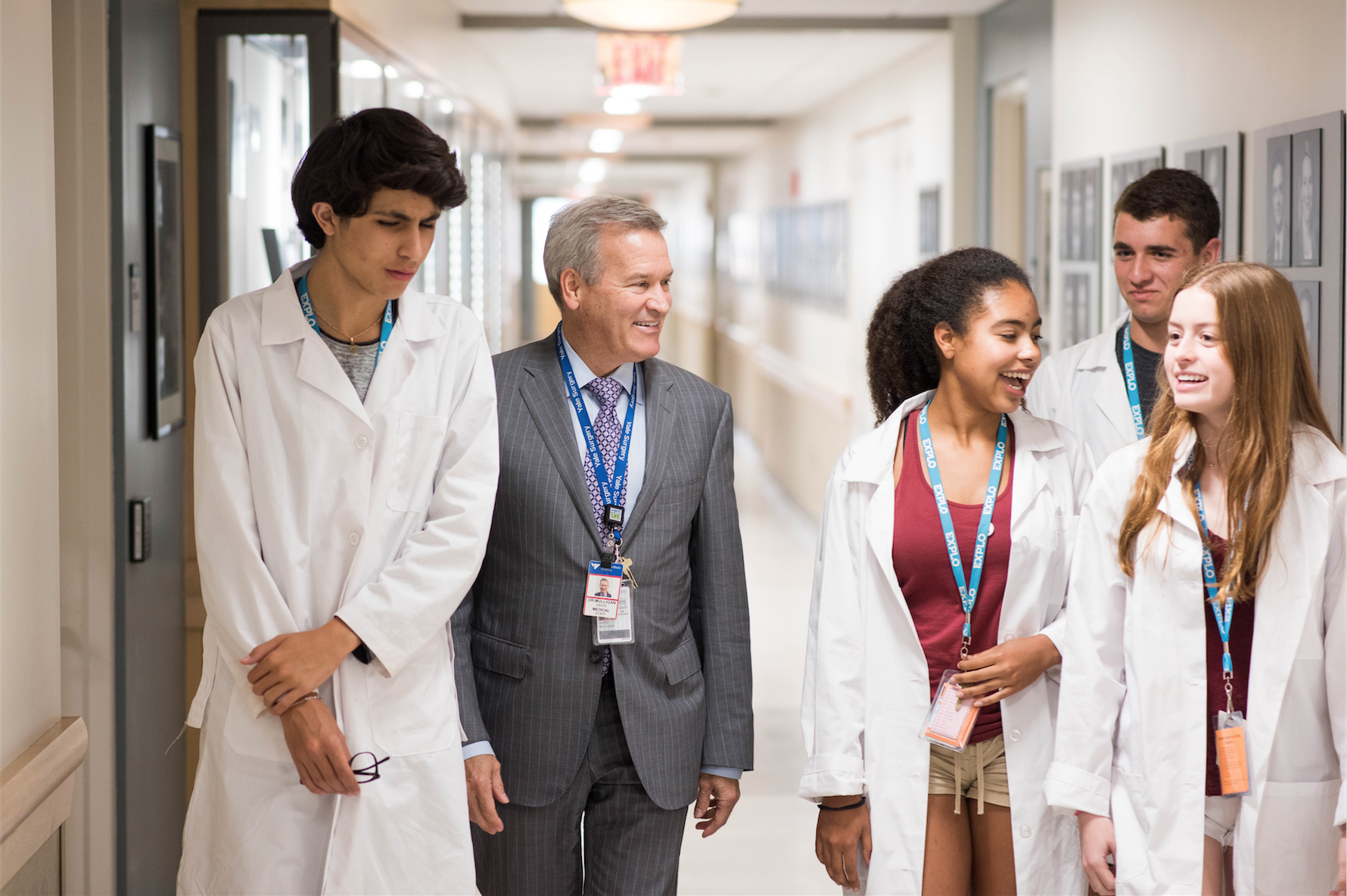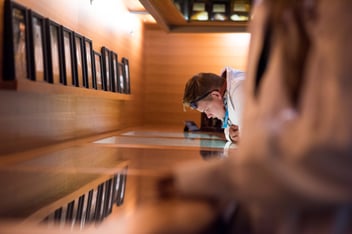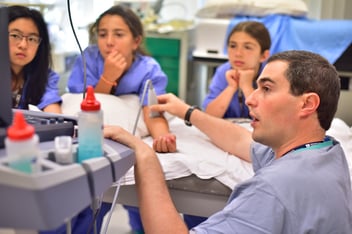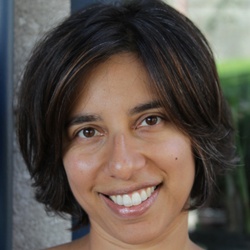The Future of Medicine is at EXPLO: International Leader in Transplantation and Immunology David Mulligan, M.D.

One of the benefits of coming to EXPLO is the direct access to the top experts in a variety of careers and academic fields. Brilliant minds like Dr. David Mulligan, an acclaimed abdominal organ transplant surgeon who recently joined the Yale-New Haven Transplantation Center as Chief of Transplantation and Immunology after 15 years at the renowned Mayo Clinic. He is internationally known for his work in living-donor liver transplantation and is a well-respected leader who is constantly pushing for innovation in treatment and patient care.
We were thrilled when Dr. Mulligan agreed to advise the Future of Medicine Focus program. He recently joined a group of EXPLO students at Yale-New Haven Hospital to talk with them about innovation in transplantation and advances in medical research that are shaping the future of medical treatment. Here are some excerpts from their conversation:
Advances in 3D Bioprinting:
The dream, Dr. Mulligan says, is to be able to recreate an organ from the patient’s own cells — eliminating the need for immunosuppression along with the complications of infection and rejection than many organ recipients currently face.
The reality may be closer than we imagine. Dr. Mulligan recently finished a textbook chapter on state-of-the-art 3D bioprinting.
“Imagine a pencil that extrudes a hollow tube. But the tube, instead of being plastic, is actually biological cells and epithelial cells with a stratus of smooth muscle cells around them. With the right computer program, you can put branches into those cells. We can actually make arteries and veins within about eight minutes,” Dr. Mulligan says. “It’s very exciting, but they’ve still go a long way to go.”
I think that’s the challenge for us all — to think outside the box and maybe combine disciplines from different domains that may have never been thought of together to have a better outcome.
Living Donor Liver Transplants, From Greek Mythology to Modern Medicine:
The regenerative properties of the liver have been known for millennia. Look back to the myth of Prometheus — the titan who, as a punishment for defying Zeus and providing fire to mankind, was chained to a rock where an eagle would eat his liver every night only to have it regenerate every morning. It’s what makes partial liver and living donor liver transplants so successful, Dr. Mulligan says.
“A liver starts regenerating immediately, within a few minutes of removing a significant amount of mass from the liver. We can take 70 percent of someone’s liver and transplant it into someone else — or take one donor and split it into two parts to transplant two patients — and the regeneration will physiologically be complete in a couple of months. It’s very fast.”
It also makes liver cells an excellent source for experimental research in bioprinting.
“We’re working on trying to make bile ducts,” Dr. Mulligan says. “You can take progenitor cells, put them onto an area where they can parasitize blood supply, and they’ll grow into little livers. They don’t have a shape like a liver, and they don’t quite get the bile ducts aligned up to major ducts, but they find their blood supply and they actually regenerate. If we can take those properties, put them together with a scaffold that we build of blood vessels and bile ducts — and maybe we could direct the bile duct formation — we can actually bioprint a liver.”
The Future of Organ Preservation and Viability:
The preservation and viability of organs eligible for transplant is another area where major leaps in research and outcomes are showing promise. Using traditional methods, most organs have to be transplanted within hours. (Imagine a heart becoming available for a child who needs a transplant, but will not get it because it would take longer than six hours for the organ to reach her.) Advances in cryopreservation and ex vivo perfusion — the method by which organs are placed on a pump and continue working outside of the body prior to be transplanted — could increase the number of organs available for viable transplant in the future.
There’s a lot of things we’re hoping for the future, but there are many ongoing practices right now with many different organs using ex vivo perfusion systems that are really exciting and help us to extend our supply.
“You can now take organs that maybe weren’t going to do well after transplant and make them better,” Dr. Mulligan says. “They’ve done it with lungs. A lung holds a lot of oxygen for up to three days. So you can take a pair of lungs and you can put them in a device that will ventilate the lungs and pump blood through the lungs, and you can actually treat that pair of lungs for pneumonia or some type of injury. This allows the lungs to improve and then you can transplant them up to three days later and they work really well.”
Dr. Mulligan is currently working to partner with engineers who can create a device that will pump livers that are too fatty or have suffered ischemia reperfusion injury so that specialists can heal them prior to transplantation. They could then be transplanted in the best possible shape — if not better than they were when they were in the donor patient’s body.
“Maybe we could make the nutritional status better,” he says. “Maybe we can, immunologically, start to modulate what’s going on in the immune system from this liver to perhaps precondition it so that when it gets to the recipient we don’t need to give as much immunosuppression. There’s a lot of things we’re hoping for the future, but there are many ongoing practices right now with many different organs using ex vivo perfusion systems that are really exciting and help us to extend our supply.”
Improving Patient Outcomes:
You always have to be thinking ahead about how to make things better, Dr. Mulligan told the students. It can be challenging to do this in surgery, he noted — to “become a caveman on a wheel” — because you become so adept at operating in one specific way with a familiar set of instruments. But advancement in robotics and technology over the past few decades has been remarkable, he says, and embracing technology in the right places can vastly improve patient outcomes.
“Robotic surgery is really translating your hand anatomy. They’re looking at tools that have what they call single port robotic surgery where you can enter just around the belly button and it becomes like a spider. A surgeon can sit in a console, look through a headset that gives him 3D vision, and can see much better than we can see in open surgery. It’s pretty extraordinary, and allows you to do things that you can’t physically do — sew right hand/left hand, even turn your wrist 360-degrees. It’s turned some surgeries completely around.”
It’s not all about the glitz and the bells and the whistles. It’s about when do you apply technology to certain conditions to make it better and when is it just more tech — not necessarily improving the outcome.
Take urological procedures, he says. They’re nearly all done robotically now.
“I wouldn’t even want to have an open prostatectomy anymore because the injury rate to the nerves in the back of the prostate were so high in the past. Now, it rarely happens with robotic surgery because of the exposure, the precision with the stitches. You don’t have the complications. It’s an amazing opportunity.”
Still, there are many incidents of unnecessary technology applications, he notes.
“In some areas they’re just applying the technology to do something that may not necessary be that much of a win. It’s more expensive, it’s not really providing better patient care. It takes some judgment. It’s not all about the glitz and the bells and the whistles. It’s about when do you apply technology to certain conditions to make it better and when is it just more tech — not necessarily improving the outcome.”
There are also a plethora of non-technological opportunities when it comes to providing improved outcomes for patients, Dr. Mulligan told the students.
“I think that’s the challenge for us all — to think outside the box and maybe combine disciplines from different domains that may have never been thought of together to have a better outcome. Consider the arts and humanities in medicine. How can something coming from the art world or the music world help surgery? I think there are a lot of neat opportunities to see as we cross along those lines.”



